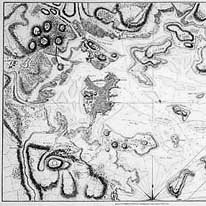Sculpting the Image of a Shapely Neck
It’s impossible to make sense of colonial Boston without knowing how the town used to be connected to the Massachusetts mainland only by a narrow strip of dry land called the Neck.
Granted, even with understanding the Neck, not all of colonial Boston’s history makes sense. But that vanished geographical reality is why:
Boston just paid homage to its past as a peninsula by installing a sculptural tribute to the Neck at the corner of Washington and East Berkeley Streets. Here are reports on the dedication from the Boston Globe and South End Patch (which for some reason calls the sculpture “infamous”).
The sculpture is titled “LandWave.” It includes an engraved map of Boston in the eighteenth century, but some people still think it might be a skateboard ramp. (Not helping is the fact that Landwave is the brand of a company that makes skateboard ramps.)
Granted, even with understanding the Neck, not all of colonial Boston’s history makes sense. But that vanished geographical reality is why:
- The Massachusetts Bay company settled on the easily defended Boston peninsula (after establishing towns at Salem and Charlestown).
- The British military was able to hold the port against a hostile population from September 1774 to March 1776, and to keep desertion relatively low.
- Paul Revere and his colleagues arranged the “one if by land, two if by sea” (actually two if by the Back Bay) signals for the different routes out of town.
- The South End is so much larger than the North End, and north of South Boston.
Boston just paid homage to its past as a peninsula by installing a sculptural tribute to the Neck at the corner of Washington and East Berkeley Streets. Here are reports on the dedication from the Boston Globe and South End Patch (which for some reason calls the sculpture “infamous”).
The sculpture is titled “LandWave.” It includes an engraved map of Boston in the eighteenth century, but some people still think it might be a skateboard ramp. (Not helping is the fact that Landwave is the brand of a company that makes skateboard ramps.)


No comments:
Post a Comment